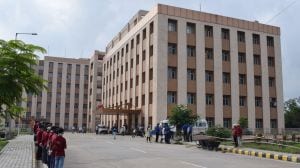In Old Delhi, a later Mughal era temple is home to ‘last surviving Vaishnav frescoes’
Standing out among a straight row of cycle shops in Chandni Chowk is a white marble temple with its pillar painted in gold colour and a painting of Lord Hanuman adorning its topmost storey. This is the Narsingh Hanuman Mandir – one of the several Mughal-era temples that dot different corners of the city. Though […]
 Narsingh Hanuman Mandir in Chandni Chowk. (Express Photo by Amit Mehra)
Narsingh Hanuman Mandir in Chandni Chowk. (Express Photo by Amit Mehra)Standing out among a straight row of cycle shops in Chandni Chowk is a white marble temple with its pillar painted in gold colour and a painting of Lord Hanuman adorning its topmost storey. This is the Narsingh Hanuman Mandir – one of the several Mughal-era temples that dot different corners of the city.
Though there is no written record of when the temple was built, it is believed that it came into being some 300 years ago, in the era of the later Mughals.
Many believe the decision to construct the temple at the present site was made after an idol of Lord Hanuman appeared under a peepal tree.
Today, the temple is known to house what is considered one of the finest Vaishnav frescoes in the Capital.
The interior walls of the temple bear several gold-painted frescoes of Lord Vishnu. On one of the walls is a fresco depicting Lord Hanuman worshipping Lord Rama, Sita and Laxman.
Speaking to The Indian Express, Shah Umair, a numismatist and an amateur historian, said, “The frescoes in this temple are very similar to the frescoes which we see in the Jain temples and Shaivite temples of Old Delhi. These are later Mughal frescoes. The architectural style is also of the later Mughal style of building a temple. What makes this significant is that this is the only known temple bearing the idol of a Narsingh form of Hanuman in Delhi.”
Further detailing on the frescoes, Umair said, “Mughal art during the later Mughal era was called the Company School of Art. So, these kinds of frescoes are called the later-Mughal frescoes… they have painted (over) the Vaishnav frescoes in Charan Das ki Bagichi recently so, I think the ones in the Narsingh Temple make these the last surviving Vaishnav frescoes…”
According to Encyclopedia Britannica, Company School is a style of miniature painting that developed in India in the second half of the 18th century in response to the tastes of the British serving with the East India Company.
In a post on Instagram, author Sam Dalrymple called it the “Golden Temple of Delhi.” He wrote: “The careless ‘renovation’ of Charan Das ki Bagichi last month destroyed the oldest Vaishnav frescoes in the capital. Having lost those, the oldest Vaishnav paintings can now be found inside Narsingh Hanuman Temple on the corner of Old Delhi’s Esplanade Road Cycle. These also lie unprotected, and most of them were painted over in the last decade. I haven’t found much documentation of the temple, although it is said to be as old as the Ram Temple, which would put it in the reign of Akbar II or Bahadur Zafar and make it a #MughalEraMandir”.
On the origin of the temple, writer Sohail Hashmi said, “ Any temple in Old Delhi can be dated back to the mid-17th century. There was nothing before this era, as Shahjahanabad did not exist before that. This temple can be dated back to a maximum of 300 years.”
Mahant Gaurav Sharma, whose family has been serving at this temple for generations, said the temple will celebrate the consecration of the Ram Mandir in Ayodhya later this month. “ In the evening, we will organise a bhandara, decorate the temple, the street outside…and we will light about 11,000 candles in front of the temple. We are lucky to be alive to witness the inauguration of the Ram Mandir and January 22 will be a festival for us,” he added.
Oblivious to the history and architectural significance of the temple, for Manu, a 22-year-old from Bihar whose family has been running a food cart next to the temple for a decade, the temple is a matter of faith.
“Yahan door door se log aate hai mannat mangne. Kuch bhi maango pura ho jata hai ( People come from far and wide to pray here. Whatever you ask for is granted),” he said.












